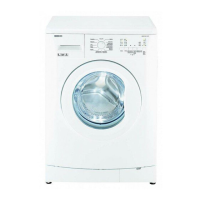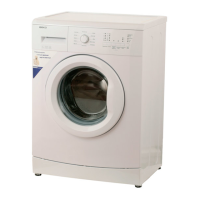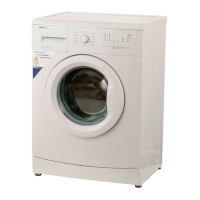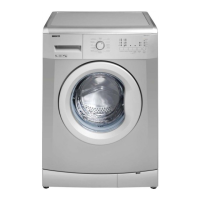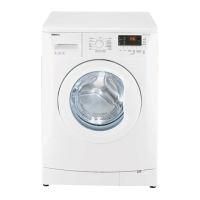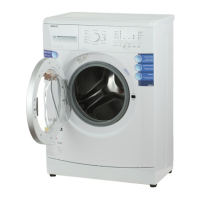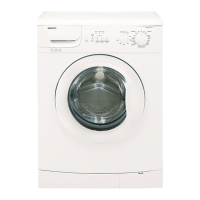
Do you have a question about the Beko WMB 50811 F and is the answer not in the manual?
| Current | 10 A |
|---|---|
| AC input voltage | 230 V |
| AC input frequency | 50 Hz |
| Power consumption (max) | 2200 W |
| Water consumption per cycle | 49 L |
| Energy consumption washing per cycle | 0.85 kWh |
| Annual water consumption washing | 9800 L |
| Annual energy consumption washing | 287 kWh |
| Control type | Buttons, Rotary |
| Loading type | Front-load |
| Product color | White |
| Built-in display | No |
| Appliance placement | Freestanding |
| Drum capacity | 5 kg |
| Spin-drying class | - |
| Maximum spin speed | 800 RPM |
| Noise level (spin) | 73 dB |
| Noise level (wash) | 60 dB |
| Number of washing programs | 16 |
| Child lock | Yes |
| Depth | 450 mm |
|---|---|
| Width | 600 mm |
| Height | 840 mm |
| Weight | 60000 g |
General safety precautions to prevent damage and ensure safe operation of the washing machine.
Specific safety instructions for electrical connections, water supply, and handling the appliance.
Instructions for the initial washing process and essential installation checks for safe operation.
Defines the product's intended purpose for home use and textile washing.
Safety measures to protect children from potential hazards associated with the washing machine.
Steps to remove packaging and transport safety bolts to prepare the machine for use.
Detailed instructions on how to safely remove transportation bolts to prevent machine damage.
Guidance on leveling the machine by adjusting its feet for stable operation.
Instructions for correctly connecting the machine to the water supply, including pressure requirements.
Procedures for attaching the drain hose securely to a washbasin or drain outlet.
Guidelines for safely connecting the appliance to an earthed power outlet.
Advice on sorting, preparing, and loading laundry items for optimal washing results.
Emphasizes the importance of not overloading the machine for proper washing results.
Information on how the door locks and unlocks during and after the washing cycle.
Details on using the detergent drawer and the correct types and amounts of detergents.
Guidance on determining the appropriate amount of detergent based on load, soiling, and water hardness.
Overview and identification of the various buttons and knobs on the washing machine's control panel.
Instructions on how to power on and prepare the washing machine for program selection.
Guide to choosing the correct wash program based on laundry type, soiling, and temperature.
Details on the primary wash programs available, such as Cottons and Synthetics.
Information on extra wash programs like Delicate, Hand wash, Mini 30, and Super.
Describes specific programs such as Rinse, Spin + Drain for particular washing needs.
Explains how to adjust the spin speed and the limitations for different fabric types.
A table detailing various programs, their duration, water, and energy consumption.
Details on special functions that can be added to wash programs for enhanced results.
Steps to initiate a selected wash program using the Start/Pause/Cancel button.
How to monitor the progress of a running wash cycle using indicators.
Instructions on how to modify program settings while a cycle is in progress.
How to temporarily pause or switch the machine to standby.
How to activate and deactivate the child lock feature to prevent accidental changes.
How to cancel a running program and the machine's response.
What happens when a program finishes, including door unlocking procedures.
Instructions for cleaning the detergent dispenser drawer and its siphon.
Guide to cleaning the filters located at the water intake valves to prevent clogging.
Steps for draining water using the emergency drain hose before cleaning the pump filter.
Instructions for draining water when no emergency drain hose is supplied.
Detailed procedure for removing and cleaning the pump filter to ensure proper drainage.
Explains potential causes and solutions when the program fails to start or select.
Addresses issues related to water leaks from the machine's base, checking hoses and filter.
Suggests solutions for temporary machine stoppage, often due to low voltage.
Explains why the time might not count down during continuous spinning, possibly due to imbalance.
Discusses scenarios where the machine continues washing without the timer progressing.
Provides a solution for excessive foaming in the detergent drawer, usually due to too much detergent.
